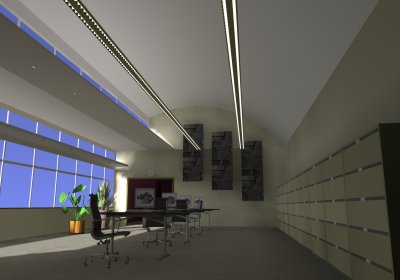
![]()
Daylighting Procedures
 The application of daylighting in AGi32 allows you to
consider the effect of sun, sky and ground as a light source in the environment.
The daily rotation of a geographical location about the sun produces a
predictable amount of sunlight from a known location. As the sunlight
enters the atmosphere, a portion of the light is scattered by the atmospheric
conditions. AGi32 uses two general methods to emulate these conditions: General CIE or IES skies (Clear, Partly Cloudy and Overcast, as well as 15 other
general sky conditions described by the CIE); and the Perez All-Weather Sky Model. Note: To use the Perez All-Weather Model, you must download and install the Weather Database. See the Weather Database - Procedures Help topic for instructions on doing this.
The application of daylighting in AGi32 allows you to
consider the effect of sun, sky and ground as a light source in the environment.
The daily rotation of a geographical location about the sun produces a
predictable amount of sunlight from a known location. As the sunlight
enters the atmosphere, a portion of the light is scattered by the atmospheric
conditions. AGi32 uses two general methods to emulate these conditions: General CIE or IES skies (Clear, Partly Cloudy and Overcast, as well as 15 other
general sky conditions described by the CIE); and the Perez All-Weather Sky Model. Note: To use the Perez All-Weather Model, you must download and install the Weather Database. See the Weather Database - Procedures Help topic for instructions on doing this.
How do I apply daylighting?
Daylighting can be applied to interior and exterior environments in AGi32. In exterior environments, the exterior surfaces must first be designated as Daylight Exterior surface types, then daylighting can be enabled and your geographical location and analysis information selected. For interior applications, the daylight will need to be "let into" the space via Daylight Transition Glass and/or Daylight Transition Openings in the Room or Object. Exterior surfaces that obstruct and/or reflect light into the interior environment can also be considered.
Once the environment specification is complete, the application of daylighting can be calculated. AGi32 provides two methods of daylighting analysis. Both require the Full-Radiosity Calculation Method:
Daylighting - This method allows you to calculate the daylight contribution for one particular moment in time (e.g., Friday, November 25, 2011 at 9:35 AM) with one general sky condition or specific Weather Station selected. The option to consider the effect of electric lighting as well is offered.
Daylight Study - This method allows you to set up multiple instances of daylight application to the environment. You can analyze several times within one day and/or several dates per your specifications. Weather Station data may be used, or multiple general sky conditions may be specified, as well as the application of electric lighting. The images created within the daylight study are saved and can be viewed with any image-viewing software.